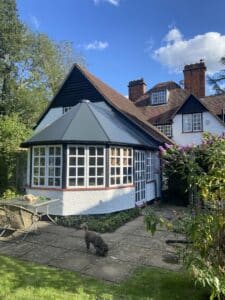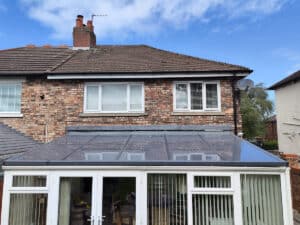When it comes to adding functional, beautiful living space to your property, two popular options often come to mind: garden rooms and conservatories. Both offer ways to make the most of your outdoor area while creating a new, usable interior space, but they are fundamentally different in design, function, and cost. Deciding which is best for your home depends on your needs, budget, and the specific purpose you have in mind. Let’s explore the pros and cons of garden rooms and conservatories to help you make an informed choice.
What is a Garden Room?
A garden room is a standalone or semi-detached structure, typically built in the garden, away from the main house. Designed to blend with the surrounding environment, these rooms often feature large windows, bi-fold doors, and contemporary finishes. Garden rooms are highly versatile and can be used as home offices, gyms, studios, or even guest accommodation.
What is a Conservatory?
A conservatory is traditionally an extension of your main house, often made primarily of glass to maximise natural light. Conservatories have been a popular addition to UK homes for decades and are frequently used as sunrooms, dining areas, or extra lounges. While their traditional designs are still prevalent, modern conservatories often incorporate advanced materials to improve thermal efficiency.
Key Comparisons
1. Purpose and Functionality
Garden Rooms: Garden rooms excel in versatility. They are detached spaces that can serve numerous purposes:
- Home office: Ideal for remote working, providing a quiet, distraction-free environment.
- Gym or studio: Plenty of natural light and privacy for fitness or creative pursuits.
- Guest accommodation: Can be outfitted with insulation, plumbing, and electrics for a comfortable stay.
- Entertainment space: Perfect for hosting parties or creating a dedicated hobby area.
The separation from the main house offers an added layer of privacy, which many homeowners find appealing.
Conservatories: Conservatories are best suited for creating additional living space connected to your home. They are often used as:
- Lounges or sunrooms: Bright and airy spaces to relax and enjoy views of the garden.
- Dining areas: A great option for those who love entertaining.
- Playrooms: Ideal for keeping an eye on children while they play.
The seamless connection to the main house makes conservatories a natural extension of your existing living space.
2. Design and Aesthetic Appeal
Garden Rooms: Modern garden rooms often feature sleek, minimalist designs that blend harmoniously with the garden. Popular materials include wood cladding, aluminium, and glass, creating a contemporary look. Garden rooms can be customised to match your preferences, from traditional timber cabins to ultra-modern studios.
Conservatories: Conservatories offer a classic aesthetic with their glass-heavy designs. Traditional models often feature ornate frames, while modern conservatories lean towards clean lines and energy-efficient materials. However, their reliance on large expanses of glass can make them less adaptable to certain architectural styles.
3. Construction and Installation
Garden Rooms: Garden rooms are typically quicker and less invasive to install compared to conservatories. Many models are prefabricated, which can significantly reduce build times. Depending on the size and specifications, a garden room can be installed in a matter of weeks. In most cases, garden rooms do not require planning permission, provided they meet permitted development criteria.
Conservatories: Building a conservatory often requires more extensive work. Foundations need to be laid, and the structure must be integrated with the main house. This can make the process lengthier and potentially disruptive. Additionally, planning permission may be needed, depending on the size and location of the conservatory.
4. Cost
Garden Rooms: The cost of a garden room can vary widely based on size, materials, and additional features. Basic models start from around £5,000, while larger, fully insulated rooms with electrics and plumbing can exceed £20,000. Despite the upfront cost, garden rooms often add value to your property.
Conservatories: Conservatories typically start at a lower price point than garden rooms, with basic models available for as little as £4,000. However, more elaborate designs with high-quality materials and features can cost upwards of £25,000. Conservatories also tend to require more maintenance over time due to the extensive use of glass.
5. Insulation and Year-Round Use
Garden Rooms: Modern garden rooms are designed for year-round use. They are typically built with high-quality insulation, double-glazed windows, and advanced materials to keep the space comfortable in any season. Heating and cooling options can also be installed for added comfort.
Conservatories: Conservatories can be challenging to use throughout the year. Older models often suffer from poor insulation, making them too cold in winter and too hot in summer. While modern conservatories use improved materials and glazing, they may still require additional heating or cooling solutions to ensure year-round comfort.
6. Privacy and Noise
Garden Rooms: The detached nature of a garden room offers superior privacy. This makes them ideal for activities that require focus or solitude, such as working, studying, or relaxing. Noise insulation can also be tailored to suit your needs.
Conservatories: As conservatories are attached to the main house, they offer less privacy. Noise from the rest of the house can easily filter in, which might not be ideal for those seeking a peaceful retreat. However, they provide a more connected feel, which can be beneficial for family living.
7. Planning Permission
Garden Rooms: In most cases, garden rooms do not require planning permission, provided they adhere to specific guidelines:
- They must be single-storey.
- The eaves height should not exceed 2.5 metres.
- The structure must not cover more than 50% of your garden.
Conservatories: Planning permission for a conservatory is more likely to be required, especially if:
- The structure exceeds permitted development limits.
- The property is listed or in a conservation area.
Pros and Cons
Garden Rooms
Pros:
- Versatile and multi-functional.
- Excellent privacy.
- Year-round usability with proper insulation.
- Adds value to your property.
Cons:
- Higher upfront cost for premium models.
- Requires sufficient garden space.
Conservatories
Pros:
- Seamlessly extends existing living space.
- Often cheaper than garden rooms (for basic models).
- Allows for plenty of natural light.
Cons:
- Less private than a garden room.
- Seasonal usability can be an issue.
- May require planning permission and ongoing maintenance.
Which is Best for Your Space?
Choosing between a garden room and a conservatory depends on your specific needs and preferences. Consider the following:
- For Work or Privacy: A garden room is the better choice due to its detached nature and ability to offer a quiet, private space.
- For Family Living: A conservatory’s integration with the main house makes it ideal for communal activities like dining or relaxing.
- For Year-Round Use: Modern garden rooms typically offer better insulation and comfort throughout the year.
- For Budget-Conscious Homeowners: A basic conservatory may be more affordable, but keep in mind the potential for higher maintenance costs over time.
- For Flexibility: Garden rooms can serve multiple purposes and can even be relocated if needed.
Final Thoughts
Both garden rooms and conservatories offer fantastic opportunities to enhance your living space and make the most of your property. By weighing the pros and cons and considering your lifestyle, budget, and long-term goals, you can confidently choose the option that’s right for you. Whether you opt for a contemporary garden room or a classic conservatory, the key is to create a space that enhances both your home and your quality of life.









